We are represented in following
English magazine:MILITARY ILLUSTRATED Nr 134 (July 1999), NAPOLEON'S LINE CAVALRY Recreated in colour
photographs (EMS Nr10) & THE
NAPOLEON'S SOLDIERS by Stephen
Maughan: Photo: Uniform
description. Copyright. Published by Window
& Greene Ltd, 5 Gerrard Street London W1V 7LJ: All rights reserved No reproduction or
transmission in any form without the prior written permission of authors or
publishers.
Photos: © Stephen
Maughan (34 North Lodge Terrace Darlington DL3 6LY England), Thierry
Blyckaerts,
David Atlan
![]() OUR WEAPONS: The dragoons of the 1st empire are equipped
with musket, sword, pistol and a shovel or axe.
OUR WEAPONS: The dragoons of the 1st empire are equipped
with musket, sword, pistol and a shovel or axe.
THE MUSKET : The dragoon
musket also has a bayonet, as the dragoon may sometimes be required to fight on
foot as well as on horseback. This is sometimes necessary due to a lack of
horses which can only be remedied when remounts are captured from the enemy as
in 1806. The other occasion is when the horses are held behind the firing line,
in a type of dismounted skirmish.
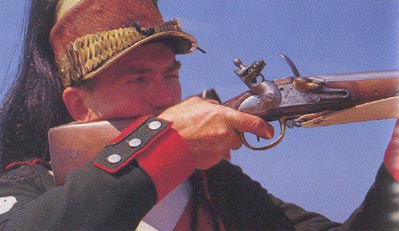 |
The musket is 1,417cm long, approximately 10cm shorter than
the infantry one and slightly longer than the light cavalry version. It has a larger iron
ring enclosing the barrel and stock to ensure stability. Some pieces are
made of brass to resist humidity from by the horse. Manufacture Impériale de St Etienne 1813 Photo: (c) St.Maughan |
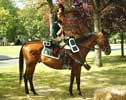 |
The FUSIL on horse. It was carried along the right side of the horse. Bottom in a kind of boot. One leather maintain the boot , another the fusil. It can also be transported on the back of the men.(Cliquer on picture to enlarge)At our request Pedersoli manufactures a replica of this gun as used in the Napoleonic wars. The gun is represented in their catalogue with an English description. The weapon has gone through the proofing procedure at their test site at Gardone Val Trompia. It is therefore capable of firing a full load ball. |
![]() CAVALERY Pistols :
Différents models were used.
CAVALERY Pistols :
Différents models were used.
The first one issued from the french revolution was the 1777 model, also
exported to the USA (Most of those were manufactured at Charleville)
 L.: 350 mm (gun 189 mm) Caliber 16.9 1,450 kg |
Made to replace the old 1763-66,
the 1777 is caractérised by simplification. Wood is replaced as
more as possible by metal and the number of pieces is limited. 75.000 pistols were produced between 1779 and 1787. (St Etienne: 28.908 Charleville: 30.684 Maubeuge: 15.000) Dragoons were oft equiped with this one. (An IX et XIII ) could'nt replace all old type. It is actually the only reproduction on the market. It is this model that equipped our group. |
Other pistols: The cavalry model Year XIII was manufactured for the French during the period 1806-1819. 300.000 were produced. 66.000 AN IX were produced from 1801 until 1807.
|
|
|
![]() Function of the flint lock pistol: The cartridge made of paper filled with gunpowder and a lead ball is taken from the
pouch.
Function of the flint lock pistol: The cartridge made of paper filled with gunpowder and a lead ball is taken from the
pouch.
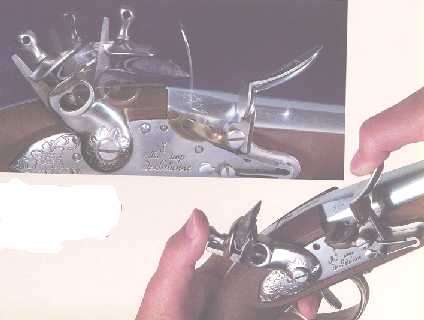 |
The cock is placed in the half cock position and the frizzen opened. The cartridge is then bitten tearing off the end, a small quantity of the powder is placed in the pan, the frizzen is then closed. The ball, along with the rest of the powder is placed in the barrel, followed by the paper. This whole is rammed firmly down the barrel. The rammer is then placed back in its receiver. The cock is pulled into the full cock position and the weapon is ready to fire. On pulling the trigger the cock holding the flint is flung forward striking the frizzen and exposing the powder in the pan. At the same time the flint strikes the metal of the frizzen a spark is caused setting off the powder in the pan which in turn sets off the powder in the barrel causing an explosion which forces the ball and paper wad from the barrel. |
![]() THE
SWORD: The
dragoons carried various models.
THE
SWORD: The
dragoons carried various models.
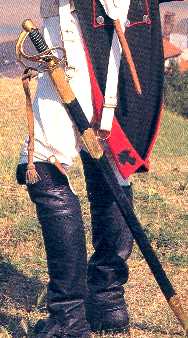 |
The model of year IV. Model year IX flat right blade of 98cm and filigree on the guard. Model year XI has four flutes on the blade, the guard being the same as Year IX. The length of the blade is 97.5cm. It is represented here. These swords had leather scabbards (instead of the steel ones which equipped the cuirassier). Note: The sword is secured to the wrist by a leather sword knot so that in the shock following a violent hit the sword will not be lost but rather hang suspended by the knot. Photo:© Stephen Maughan |
![]() THE
TOOL: Given the comando actions to be undertaken, the dragons share an axe or a
shovel that permit sapper's work to clear a road, demolish barricades, etc..
THE
TOOL: Given the comando actions to be undertaken, the dragons share an axe or a
shovel that permit sapper's work to clear a road, demolish barricades, etc..
In summary, the equipped dragon is a complete soldier capable of executing all missions; he only lacks a cannon. !
September 2002 at the Rgt in Saumur. (Clic to
enlarge)
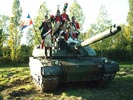
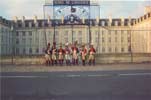
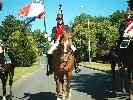
![]() HOME
HOME
Clic to ADD
www.2dragons.be
to your Favorites